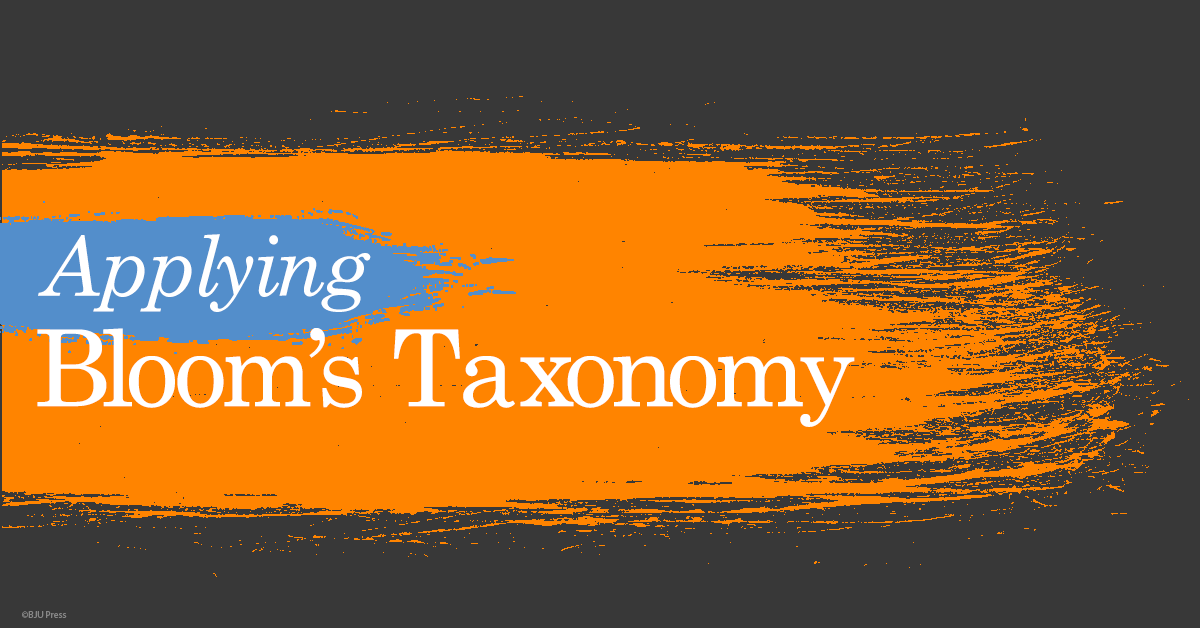As parents, you want your children to succeed in every area of their lives, and as home educators, you especially want them to succeed in their education. A good way to visualize your goals for your children’s education is through Bloom’s Taxonomy.
Dr. Benjamin Bloom described what he believed to be the best processes for learning. Though he identified three different domains of learning, we are all most familiar with the cognitive domain, which has to do with knowledge. Understanding his process can help you to fulfill the greater purpose of education—education isn’t just about learning facts and figures. It’s a process that continuously encourages children to grow and think critically. Bloom’s Taxonomy verbalizes the process so that we can aim for a clearer goal in education—being able to master concepts so that we can create new concepts.

Since the best way to learn something is to see it applied, here is Bloom’s process for the cognitive domain applied to learning nouns. (To keep it simple, we’ll focus on the rule that says nouns are words that refer to persons, places, or things.)
Level One: Knowledge/Remembering
The first level focuses on facts and recall. It has nothing to do with what the rule means, implies, or suggests, it only focuses on knowing what the rule says. Our rule is “Nouns are words that refer to persons, places, or things.”
Level Two: Comprehension/Understanding
Comprehension is one step beyond simple recall. It demonstrates that you not only know what the rule is word for word, but you also know what those words mean and you can put the rule into your own words to express the same concept. To understand the “noun as a person, place, or thing” rule, you have to know what a person is, what a place is, and so on. Putting the rule into my own words, I might say that people’s names, specific or general locations, and objects are all referred to with nouns.
Level Three: Application/Applying
Level three begins the step where textbook practices and exercises come in. Here we take our rule and look at something it applies to. That means taking a sample sentence and finding and labeling all the nouns, based on our rule.
For example, “Amy (person) wanted to move back to Scotland (place), but her aunt (person) didn’t have enough money (thing) for the move (thing).”
Level Four: Analysis/Analyzing
Analysis involves grouping information into parts. It’s a question-and-answer process that might reveal more about our rule. When I put the rule into my own words, I changed things to objects because I felt that objects better indicates the tangible nature of things. But in the example sentence above, I’ve identified the second move as a noun, not a verb. Why is it a noun and not a verb? When we’re analyzing, we need to recognize that some words may be nouns that refer to persons, places, or things even if they’re normally used as a different part of speech. While we’re thinking about it, we may notice that we can classify the second move as a noun, but not the first one.
Levels Five and Six: Evaluation/Evaluating and Synthesis/Creating
Originally, Bloom’s fifth level was synthesis, and his sixth was evaluation. But a group of Bloom’s former students revised his original process in the 1990s. Under the revised version, evaluating became the fifth level, and creating became the sixth.
Evaluating involves forming conclusions based on new and prior knowledge and being able to support those conclusions with that knowledge. Here we should be able to look at what we discovered in our analysis step and explain why we came to the conclusion that we did. In the example sentence above, we know that move usually indicates an action, like when we first used it, but the second time it’s used in a tangible, countable sense, not as an action.
This step marks the end of most forms of practice exercises in many textbooks. But we need to go on to the last level in order to demonstrate true knowledge of a concept.
The final level in the revised model is creating. Creating requires using all prior knowledge in order to form a new idea. It goes beyond reading a new sentence and identifying parts of speech. Creation demonstrating a mastery of nouns would require putting together a new sentence using nouns intentionally and naturally. For example, in the following sentence, I’ve created a situation to use words that would often act as verbs (love and traveling) as nouns in order to show what we discovered about things.
“Amy decided that her love of traveling was more important to her than her love of Scotland.”
Bloom’s process relies on a widening foundation of knowledge, and BJU Press homeschool curriculum references the Revised Bloom’s Taxonomy, especially in math and vocabulary. Check out our math curriculum or vocabulary curriculum to see how we do it!
Leave a Reply